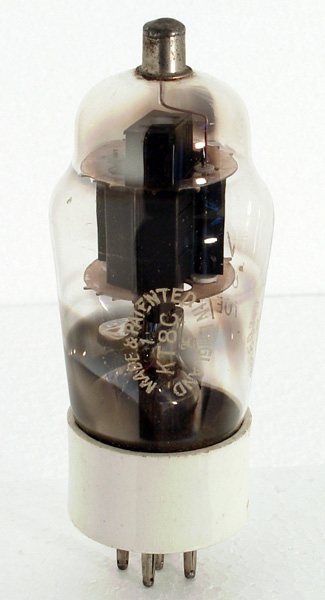|
KT8CSensibly equivalent¶ to:See also:
|
|
|

|
The KT8C was a not very successful British attempt to emulate the American type 807. The almost identical KT8 has a plastic base cap whereas the KT8C has a ceramic base cap that offered better insulation characteristics in humid conditions such as use in aircraft.The 807 was based on the RCA type 6L6 beam tetrode, which had a long, fairly thin, anode and a carefully-aligned grid structure. The 6L6 employed rapidly-accelerated electrons and short electron paths. This made it efficient but its characteristic had a distinct residual kink. It was a very successful valve but its characteristic was not quite straight enough to give the ultimate in audio quality at high output levels.The KT66 was essentially a 6L6G redesigned with a larger cathode and a shorter, fatter anode. The KT66 had less rapid acceleration, longer electron paths, and almost no kink. It was ace for audio hi-fi but the electrons took longer to reach the anode and were more open to influence from magnetic, etc, fields on the way. Moreover, under HF conditions the electron stream was not perfectly in phase with the grid signal and this resulted in a loss of output power.The KT8C was based on the KT66 but the longer electron path (compared to the 6L6 and 807 types) was a disadvantage at the high radio frequencies. Not a problem at AF but the KT8C was pretty useless above 15 MHz whereas the 807 was still doing great things at 60 MHz.In the end the British Services abandoned the KT8C in favour of the American 807. Attempts to make 807s in the UK were largely unsuccessful.The anode is made of plates, shaped to increase surface area and blackened to radiate more heat.The classic envelope is 47 mm in diameter and, excluding the B5 base pins, is 115 mm tall.References: Private communication. Type KT8C was first introduced in 1938. See also 1938 adverts. |
Pin Connections
| 1 | 2 | 3 | 4 | 5 | tc |  g2 | g1 | h | h | k | a |
|
|
Absolute Maximum Operating Conditions¶
| Vh | Ah | Va | Vs | Vg | mAa | mAs | Pdriv | Pdiss | Pout | freq | f.max | 
| 6.3 | 1.27 | 600 | 300 | -100 | 85 | 6.0 | 0.5 | 25 | 38 | 25MHz | 100MHz |
|
Updated January 26, 2017.
|
|